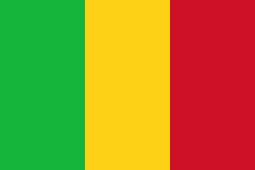Flag of Mali
 | |
| Use | National flag |
|---|---|
| Proportion | 2:3 |
| Adopted | March 1, 1961 |
| Design | A vertical tricolour of green, gold and red. |
 | |
| Use | National flag |
| Adopted | April 4, 1959 |
| Design | A vertical tricolour of green, gold and red with a human stick figure (kanaga) in black with arms raised to the sky centered in the gold band. |
The national flag of Mali (French: drapeau du Mali) is a tricolour with three equal vertical stripes. From the hoist (the place where the flagpole meets the flag) the colours are green, gold, and red, the pan-African colours. The flag of Mali is almost identical to the flag of Guinea, with the exception that the colours are in reverse order.
Symbolism
The green stands for fertility of the land, gold stands for purity and mineral wealth, and the red symbolizes the blood shed for independence from the French. [1]
Color schemes
(1961–present) |
Green | Yellow | Red |
|---|---|---|---|
| Pantone | 2271c | 115c | 3546c |
| CMYK | 91-0-100-0 | 0-9-100-0 | 0-86-63-0 |
| RGB | 20-181-58 | 252-209-22 | 206-17-38 |
| Hexadecimal | #14B53A | #FCD116 | #CE1126 |
History
The current flag was adopted on March 1, 1961. The original flag was adopted on April 4, 1959, when Mali joined the Mali Federation. This flag was the same, except the golden stripe had a human stick figure, a kanaga, in black, with arms raised to the sky. The figure was removed due to the opposition, in a country whose population is 90% Muslim, of Islamic fundamentalists[2] (see Aniconism in Islam, the belief against making pictures of the human figure).[3]
References
- ^ "What Do The Colors And Symbols Of The Flag Of Mali Mean?". WorldAtlas.
- ^ "Flag of Mali". Encyclopedia Britannica.
- ^ Guide to the Flags of the World by Mauro Talocci, revised and updated by Whitney Smith (ISBN 0-688-01141-1), p. 124.
